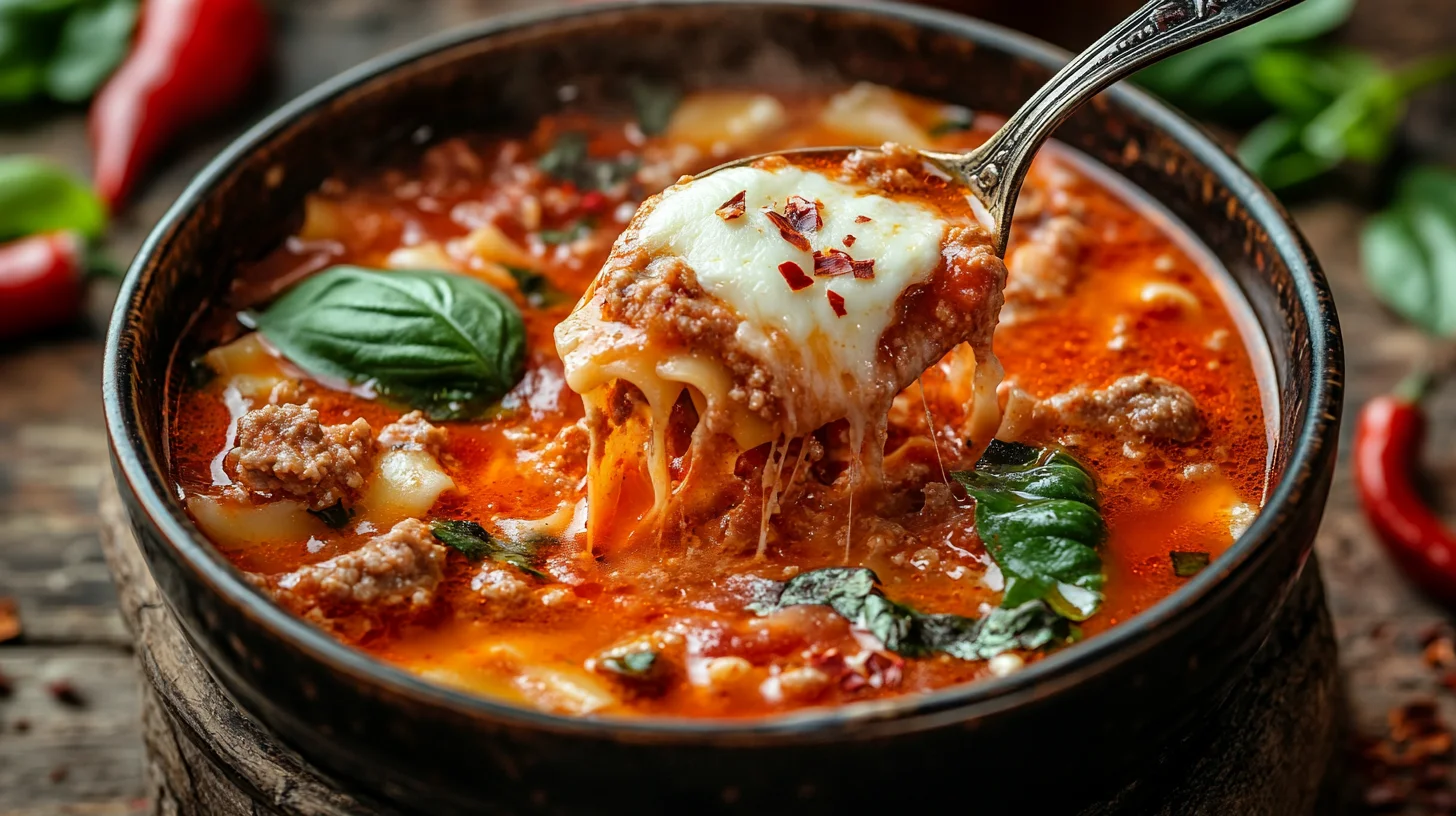Lasagna is one of the most beloved comfort foods, but making a gluten-free version can be a challenge—especially if you’re craving something quick and easy. That’s where gluten-free lasagna soup comes in! This dish offers all the rich, cheesy, and savory flavors of traditional lasagna but in a warm, hearty bowl of soup. It’s perfect for anyone following a gluten-free diet or simply looking for a new way to enjoy a classic Italian favorite.
Unlike classic lasagna, which requires layering noodles, cheese, and sauce in a baking dish, this one-pot meal simplifies the process while maintaining all the delicious elements. With gluten-free pasta, a well-seasoned tomato-based broth, and a blend of ricotta, mozzarella, and Parmesan, this soup delivers the ultimate comfort food experience—without the hassle of layering or baking.
Beyond being gluten-free, this recipe is also highly adaptable. Whether you prefer a meat-based version with ground beef or turkey or a vegetarian option packed with veggies, there’s a way to make it suit your taste. You can even adjust the texture—some like it thick and creamy, while others enjoy a brothier, lighter version.
In this guide, we’ll explore everything you need to know about gluten-free lasagna soup, including the best ingredients, how to prepare it, and some pro tips for making it perfect every time. By the end, you’ll have a go-to recipe that’s easy, delicious, and sure to become a staple in your home.
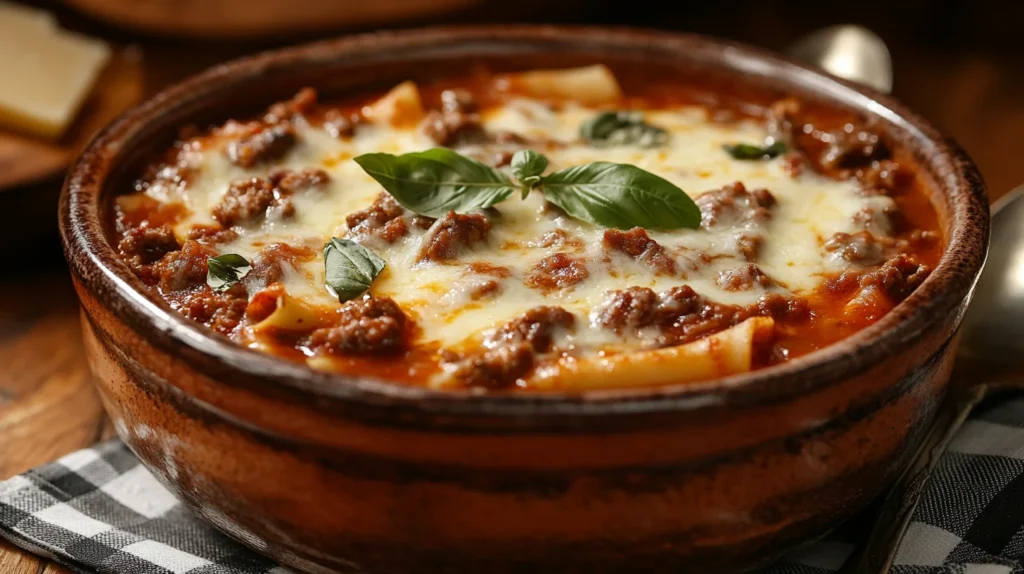
What is Gluten-Free Lasagna Soup?
Gluten-free lasagna soup is a comforting, one-pot meal that captures the flavors of traditional lasagna but in a soup form—without the need for layering or baking. Instead of using standard wheat-based lasagna noodles, this version features gluten-free pasta, ensuring that those with gluten sensitivities or celiac disease can still enjoy this hearty dish.
How is Gluten-Free Lasagna Soup Different from Traditional Lasagna?
While traditional lasagna is baked in layers of pasta, cheese, and meat sauce, Gluten-Free Lasagna Soup deconstructs these ingredients into a rich, flavorful broth. The result is a soup that has:
The richness of lasagna sauce – A well-seasoned, tomato-based broth infused with Italian herbs.
Cheesy goodness – Ricotta, mozzarella, and Parmesan create the creamy texture.
Tender pasta – Gluten-free noodles make the dish accessible to those avoiding wheat.
A warm and cozy feel – Perfect for colder days or whenever you need comfort food.
Who Should Try Gluten-Free Lasagna Soup?
This dish is ideal for:
- Gluten-Free Dieters – Those with celiac disease or gluten sensitivity.
- Busy Home Cooks – A one-pot meal that’s easy to make and clean up.
- Lasagna Lovers – If you love traditional lasagna but want something quicker and easier.
- Families – A kid-friendly meal that pleases everyone at the table.
Ingredients for Gluten-Free Lasagna Soup
Gluten-Free Pasta Options
Choosing the right pasta is key to a great Gluten-Free Lasagna Soup. Unlike wheat pasta, gluten-free varieties can become mushy if overcooked. Here are the best options:
Brown rice pasta – Holds up well in soups and maintains its shape.
Chickpea pasta – Adds protein and fiber while staying firm.
Quinoa pasta – A nutrient-rich option that doesn’t fall apart easily.
Lentil pasta – A great high-protein alternative.
Tip: Cook the pasta separately and add it to the soup just before serving to prevent it from becoming too soft.
Choosing the Right Broth
A flavorful broth is the base of a great lasagna soup. However, not all broths are Gluten-Free Lasagna Soup. When buying store-bought broth, check for hidden gluten in ingredients like:
- Wheat-based thickeners
- Soy sauce (often contains wheat)
- Malt extract (made from barley)
For the best results, opt for homemade broth or a trusted Gluten-Free Lasagna Soup brand. You can use:
Chicken broth – Adds a rich, savory depth.
Beef broth – Gives a heartier, more robust flavor.
Vegetable broth – Perfect for a lighter or vegetarian version.
Cheese Selection
Cheese is a key ingredient in Gluten-Free Lasagna Soup, and luckily, most natural cheeses are gluten-free. However, some pre-shredded cheeses contain anti-caking agents that may contain gluten. Opt for:
Ricotta cheese – Creates a creamy texture.
Mozzarella cheese – Melts beautifully into the soup.
Parmesan cheese – Adds a nutty, salty finish.
Tip: If using store-bought shredded cheese, check the label to ensure it’s 100% gluten-free.
Protein Choices for a Gluten-Free Lasagna Soup
Adding protein makes this soup even more filling. You can choose:
Ground beef – A classic choice for lasagna flavors.
Ground turkey or chicken – A leaner alternative.
Italian sausage – Adds extra spice and flavor.
Plant-based crumbles or mushrooms – A great vegetarian option.
How to Make Gluten-Free Lasagna Soup
Now that we have all the ingredients ready, let’s dive into the step-by-step process of making this delicious gluten-free lasagna soup. This recipe is easy to follow and perfect for busy weeknights when you want a comforting meal without spending hours in the kitchen.
Preparing the Base
The foundation of a great Gluten-Free Lasagna Soup lies in a flavorful, well-seasoned base. Here’s how to do it:
1️⃣ Sauté the Aromatics
- Add 1 diced onion and sauté until soft and translucent (about 3–4 minutes).
- Stir in 3–4 minced garlic cloves and cook for another 30 seconds until fragrant.
2️⃣ Brown the Meat (or Plant-Based Alternative)
- If using ground beef, turkey, or sausage, add 1 pound to the pot.
- Cook until browned, breaking it up with a spoon. Drain excess grease if needed.
- For a vegetarian version, add chopped mushrooms or a plant-based alternative at this step.
3️⃣ Add the Seasonings and Tomatoes
- Stir in 1 teaspoon of dried oregano, 1 teaspoon of dried basil, ½ teaspoon of red pepper flakes (optional), and salt & pepper to taste.
- Pour in 1 (28-ounce) can of crushed tomatoes and 1 (15-ounce) can of tomato sauce for a rich, lasagna-like broth.
4️⃣ Pour in the Broth
- Add 4 cups of gluten-free chicken, beef, or vegetable broth.
- Stir well and bring to a gentle simmer. Let it cook for 15–20 minutes so the flavors meld together.
Cooking the Gluten-Free Lasagna Soup Pasta
Cooking gluten-free pasta the right way is essential to avoid a mushy texture.
✔ (Best for Meal Prep) – Cook the pasta separately
- Add 8 ounces of gluten-free lasagna noodles (broken into bite-sized pieces).
- Drain and rinse with cold water to stop the cooking process.
✔ (One-Pot Convenience) – Cook pasta in the soup
- Add uncooked gluten-free pasta directly to the simmering soup.
- Stir occasionally and cook for about 8–10 minutes or until the pasta is tender.
- Be careful not to overcook, as gluten-free pasta tends to break apart easily.
Adding Cheese and Final Touches
1️⃣ Mix in the Ricotta Cheese
- In a small bowl, combine 1 cup of ricotta cheese, ½ cup of shredded mozzarella, and ¼ cup of grated Parmesan.
- Stir this mixture into the soup for a creamy, cheesy texture.
2️⃣ Melt Extra Cheese on Top
- Sprinkle additional mozzarella on top and let it melt into the hot soup.
- For an oven-baked effect, transfer the soup to an oven-safe dish, top with cheese, and broil for 2–3 minutes until bubbly.
3️⃣ Garnish and Serve
- Sprinkle fresh chopped basil or parsley over the soup.
- Serve hot with a side of gluten-free garlic bread or a fresh salad.
Tips for the Best Gluten-Free Lasagna Soup
Making a delicious gluten-free lasagna soup isn’t just about following the recipe—it’s about mastering the little details that make a big difference in texture and flavor. Below are some pro tips to ensure your soup turns out perfect every time.
Preventing Mushy Pasta
Gluten-free pasta has a tendency to break apart or become mushy if overcooked. Here’s how to avoid that:
✔ Cook the pasta separately: This helps control the texture and prevents it from soaking up too much broth. Add it just before serving.
✔ Undercook the pasta slightly: If cooking it in the soup, take it off the heat 1–2 minutes before it’s fully cooked to prevent over-softening.
✔ Use sturdy pasta: Brown rice pasta and chickpea pasta hold up better than corn or white rice pasta.
Adjusting the Thickness
Some people prefer a thick, stew-like soup, while others enjoy a more brothy version. Here’s how to adjust it:
✔ For a thicker soup: Simmer longer to reduce the liquid or stir in more ricotta cheese or tomato paste.
✔ For a thinner soup: Add more broth or even a splash of warm water before serving.
How to Store and Reheat Gluten-Free Lasagna Soup
Since gluten-free pasta can become soggy when stored, here’s the best way to store leftovers:
✔ Store soup and pasta separately: Keep the soup in an airtight container in the fridge for up to 4 days. Store the pasta in a separate container and mix in when reheating.
✔ Reheat gently: Warm the soup on the stovetop over medium-low heat, stirring occasionally. If the soup thickened in the fridge, add a little broth or water to loosen it.
✔ Avoid microwaving pasta: If reheating in the microwave, heat the soup separately, then add the pasta right before eating.
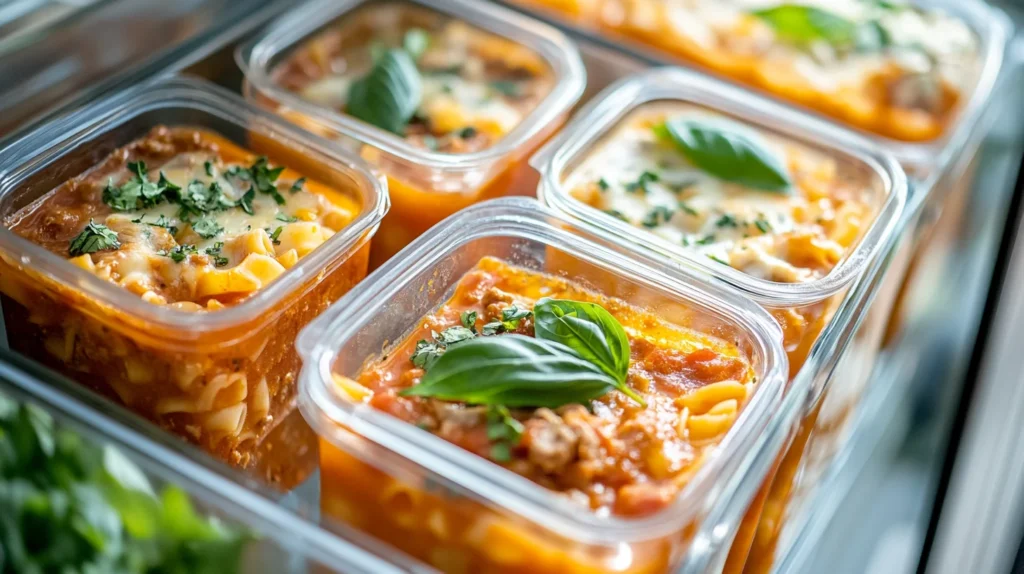
Making it Even More Flavorful
Want to take your lasagna soup to the next level? Try these simple tricks:
✔ Use fire-roasted tomatoes for a deeper, smoky flavor.
✔ Add a Parmesan rind while simmering for extra richness.
✔ Splash in a bit of balsamic vinegar to enhance the tomato flavor.
✔ Sprinkle in red pepper flakes for a spicy kick.
Variations of Gluten-Free Lasagna Soup
One of the best things about gluten-free lasagna soup is its flexibility. Whether you’re avoiding dairy, looking for a vegetarian version, or want a spicy kick, there’s a variation for everyone. Here are some delicious ways to customize your soup to fit your dietary preferences.
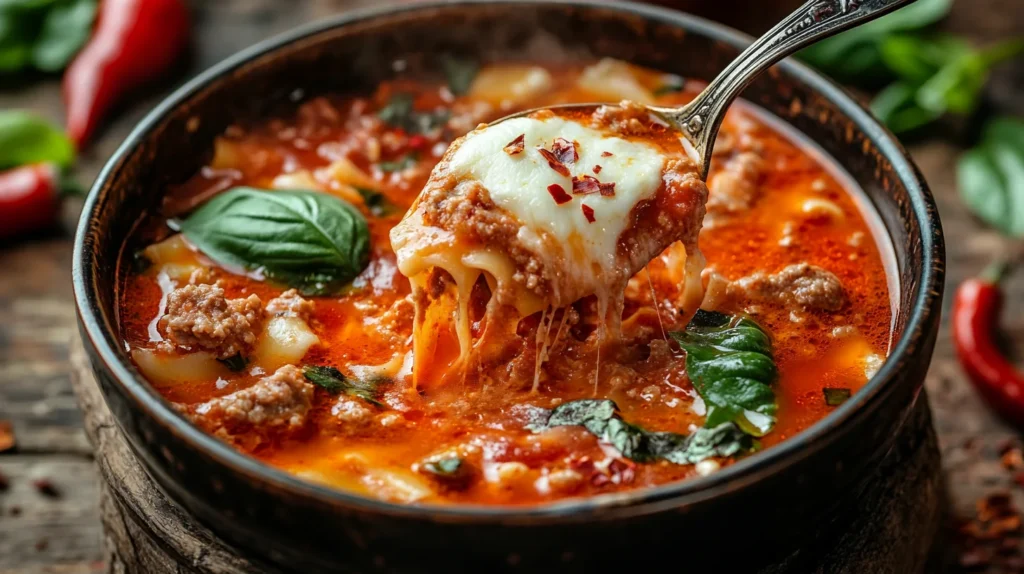
Dairy-Free Version
If you’re lactose intolerant or following a dairy-free diet, you can still enjoy a creamy, cheesy lasagna soup without traditional cheese.
Substitutions:
✔ Use dairy-free ricotta: Brands like Kite Hill or homemade cashew ricotta work well.
✔ Swap mozzarella for dairy-free cheese: Violife, Daiya, or Miyoko’s offer great options.
✔ Skip the cheese entirely and add coconut milk: A splash of full-fat coconut milk creates creaminess without dairy.
✔ Use nutritional yeast: This adds a cheesy flavor without actual cheese.
Tip: Because dairy-free cheeses don’t always melt like traditional cheese, consider blending them into the broth for a smoother texture.
Vegetarian and Vegan Options
You don’t need meat to make this soup flavorful and satisfying!
Substitutions:
✔ Replace the ground meat with mushrooms, lentils, or plant-based crumbles. Mushrooms provide a meaty texture, while lentils add protein and fiber.
✔ Use vegetable broth instead of chicken or beef broth.
✔ For a vegan version, replace the cheese with dairy-free alternatives or use nutritional yeast.
Tip: Adding roasted red peppers or sautéed zucchini enhances the flavor and texture.
Spicy Lasagna Soup
If you love a little heat, this variation is for you!
How to make it spicy:
✔ Use hot Italian sausage instead of ground beef.
✔ Add red pepper flakes or cayenne pepper for an extra kick.
✔ Stir in a spoonful of Calabrian chili paste or harissa for deep, smoky heat.
✔ Top with spicy pepper jack cheese instead of mozzarella.
Tip: Taste as you go—some spice levels build over time!
Low-Carb and Keto Version
If you’re looking for a low-carb alternative, you can still enjoy lasagna soup without pasta.
Substitutions:
✔ Use zucchini noodles (zoodles) or shirataki noodles instead of gluten-free pasta.
✔ Add extra cheese and meat to make it more filling.
✔ Use a cream-based broth instead of tomato-heavy sauce.
Tip: If using zoodles, add them at the very end to prevent them from getting soggy.
Extra Protein-Packed Version
Want to boost your protein intake? Here’s how:
✔ Use chickpea or lentil pasta instead of traditional gluten-free pasta.
✔ Double the meat or add extra beans.
✔ Stir in a beaten egg at the end for a silky, protein-rich texture.
✔ Top with extra shredded cheese for more protein.
For a truly comforting meal, pair this Gluten-Free Lasagna Soup with a homemade meatball sub for a hearty Italian-inspired feast. If you’re looking for an easy and delicious appetizer to serve alongside, try these chicken stuffed crescent rolls—flaky, cheesy, and perfect for dipping into the soup. And for a sweet finish, treat yourself to a moist and flavorful carrot bundt cake that pairs beautifully with a cup of coffee or tea. 🍲🥖🧁
Frequently Asked Questions
What does gluten-free soup mean?
A gluten-free soup is a soup made without any ingredients that contain gluten, a protein found in wheat, barley, and rye. This means using gluten-free pasta, broth, and seasonings that do not contain wheat-based thickeners or additives. Many store-bought soups contain hidden gluten in flavoring agents, so it’s essential to check ingredient labels.
How long to cook gluten-free lasagne?
Cooking time depends on the type of gluten-free lasagna noodles you’re using:
✔ Oven-ready gluten-free lasagna noodles typically take 35–40 minutes when baked in a traditional lasagna dish.
✔ Boil-first gluten-free lasagna noodles usually cook in 8–12 minutes in boiling water before layering.
✔ In lasagna soup, gluten-free pasta should be cooked separately and added just before serving to prevent it from getting too soft. If cooking in the soup, boil for 8–10 minutes, checking for doneness.
How much protein is in lasagna soup?
The protein content in lasagna soup depends on the ingredients used. On average:
✔ A serving with ground beef (or turkey) and cheese contains 20–25g of protein per bowl.
✔ A vegetarian version with lentils or chickpea pasta can provide 15–20g of protein per serving.
✔ Adding extra cheese, meat, or a protein-rich broth can further increase the protein count.
Do gluten-free lasagna noodles taste the same as regular?
Gluten-free lasagna noodles can taste slightly different from regular wheat-based noodles. However, the taste and texture depend on the type of gluten-free pasta used:
✔ Brown rice pasta has a mild, slightly nutty flavor and a chewy texture, making it the closest to traditional pasta.
✔ Chickpea or lentil pasta has an earthy taste and slightly firmer texture.
✔ Corn-based gluten-free pasta tends to be softer and may break apart more easily.
✔ Quinoa pasta has a distinct flavor but holds up well in soups.
Tip: Cooking gluten-free pasta al dente and serving it immediately helps maintain the best texture!
Conclusion
Gluten-free lasagna soup is the perfect way to enjoy all the classic flavors of lasagna in a quick, easy, and comforting one-pot meal. Whether you’re following a gluten-free diet due to celiac disease, gluten sensitivity, or simply looking for a lighter alternative to traditional lasagna, this soup offers a delicious and satisfying solution.
By using gluten-free pasta, a flavorful tomato-based broth, and creamy cheese, this dish brings all the rich textures and taste of lasagna without the hassle of layering and baking. Plus, with so many variations—from dairy-free and vegetarian options to spicy and protein-packed versions—you can customize this soup to fit your dietary needs and flavor preferences.
To make the best gluten-free lasagna soup, remember to:
✔ Choose the right gluten-free pasta and cook it separately if possible.
✔ Use high-quality broth and fresh ingredients for maximum flavor.
✔ Adjust the consistency to your liking—thicker for a stew-like dish or thinner for a brothy soup.
✔ Store leftovers properly to maintain texture and taste.
Whether you’re making this soup for a cozy family dinner, a quick weeknight meal, or meal prep for the week, it’s sure to become a go-to recipe in your kitchen. Enjoy the warm, cheesy, and hearty goodness of gluten-free lasagna soup today!🍲🧀
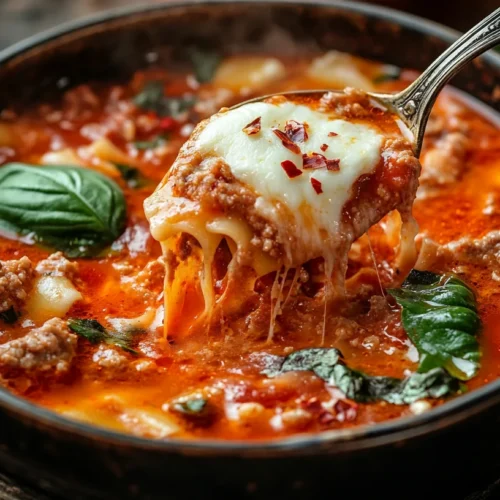
Gluten-Free Lasagna Soup – A Cozy, Cheesy One-Pot Meal
Equipment
- ✔ Large soup pot or Dutch oven
- ✔ Wooden spoon for stirring
- ✔ Ladle for serving
- ✔ Small mixing bowl for cheese mixture
- ✔ Measuring cups and spoons
- ✔ Chef’s knife and cutting board
Ingredients
- For the Soup Base:
- 2 tablespoons olive oil
- 1 small onion diced
- 3 garlic cloves minced
- 1 pound ground beef or ground turkey
- 1 teaspoon dried oregano
- 1 teaspoon dried basil
- ½ teaspoon red pepper flakes optional, for spice
- Salt and black pepper to taste
- 1 28-ounce can crushed tomatoes
- 1 15-ounce can tomato sauce
- 1 tablespoon tomato paste
- 4 cups gluten-free chicken or vegetable broth
- 1 teaspoon Italian seasoning
- 1 teaspoon sugar optional, to balance acidity
- For the Pasta:
- 8 ounces gluten-free lasagna noodles broken into bite-sized pieces
- Water for boiling if cooking separately
- For the Cheese Mixture:
- 1 cup ricotta cheese
- ½ cup shredded mozzarella cheese
- ¼ cup grated Parmesan cheese
- 1 tablespoon fresh chopped basil or 1 teaspoon dried basil
- For Garnishing:
- Additional shredded mozzarella and Parmesan
- Fresh basil or parsley
- Red pepper flakes optional
Instructions
- Step 1: Sauté the Aromatics & Meat
- Heat olive oil in a large pot over medium heat.
- Add the diced onion and sauté until soft, about 3–4 minutes.
- Stir in minced garlic and cook for another 30 seconds until fragrant.
- Add the ground beef (or turkey) and cook until browned, breaking it up as it cooks. Drain any excess fat.
- Step 2: Build the Soup Base
- Stir in oregano, basil, red pepper flakes, salt, and black pepper.
- Add crushed tomatoes, tomato sauce, tomato paste, and broth. Stir well.
- Mix in Italian seasoning and sugar (if using).
- Bring the soup to a simmer and let it cook for 15–20 minutes to develop flavors.
- Step 3: Cook the Gluten-Free Pasta
- Option 1 – Cook Separately (Best for Texture):
- Bring a pot of salted water to a boil. Add the gluten-free pasta and cook until al dente (check package instructions). Drain and rinse under cold water.
- Option 2 – Cook in the Soup (For Convenience):
- Add uncooked pasta directly to the simmering soup. Stir occasionally and cook for 8–10 minutes, or until the pasta is tender.
- Step 4: Prepare the Cheese Mixture
- In a small bowl, mix ricotta, shredded mozzarella, grated Parmesan, and fresh basil.
- Step 5: Final Touches & Serving
- Remove the soup from heat and stir in a spoonful of the cheese mixture for a creamy texture.
- Ladle the soup into bowls and top each serving with extra mozzarella, Parmesan, and fresh basil.
- Serve hot with gluten-free garlic bread or a fresh side salad.
Notes
✔ For a dairy-free version: Use dairy-free ricotta and mozzarella.
✔ For a vegetarian version: Swap the meat for mushrooms or lentils.
✔ For extra spice: Add more red pepper flakes or use spicy Italian sausage.

